Determinants of Capital Structure in Sri Lankan Hotels and Restaurants
VerifiedAdded on 2022/05/18
|7
|1901
|22
Report
AI Summary
This report examines the determinants of capital structure for listed hotels and restaurants in Sri Lanka, specifically those listed on the Colombo Stock Exchange (CSE) from 2014 to 2018. The study investigates the relationship between capital structure and various determinants, aiming to identify factors influencing financing decisions. The research addresses the research gap by analyzing the capital structure of firms in a developing economy, considering theories such as the static Trade off theory, Pecking order theory and Agency cost theory. The study aims to answer questions regarding the determinants of capital structure and their relationship, providing insights for investors, managers, and lenders. The report outlines the limitations, including the five-year data period and focus on the hotel and restaurant sector, and is organized into five chapters covering the introduction, literature review, methodology, results, and conclusions.
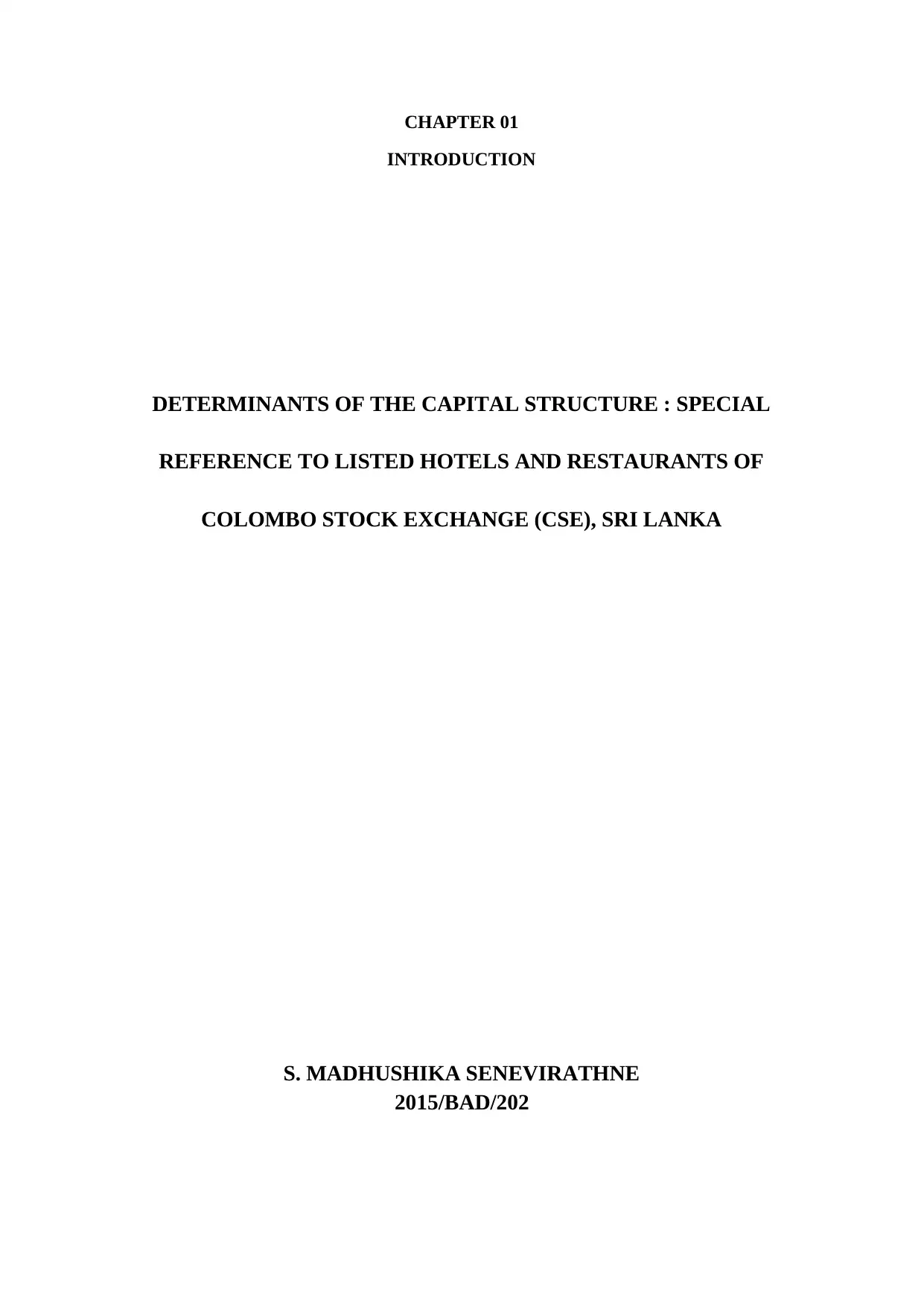
CHAPTER 01
INTRODUCTION
DETERMINANTS OF THE CAPITAL STRUCTURE : SPECIAL
REFERENCE TO LISTED HOTELS AND RESTAURANTS OF
COLOMBO STOCK EXCHANGE (CSE), SRI LANKA
S. MADHUSHIKA SENEVIRATHNE
2015/BAD/202
INTRODUCTION
DETERMINANTS OF THE CAPITAL STRUCTURE : SPECIAL
REFERENCE TO LISTED HOTELS AND RESTAURANTS OF
COLOMBO STOCK EXCHANGE (CSE), SRI LANKA
S. MADHUSHIKA SENEVIRATHNE
2015/BAD/202
Paraphrase This Document
Need a fresh take? Get an instant paraphrase of this document with our AI Paraphraser
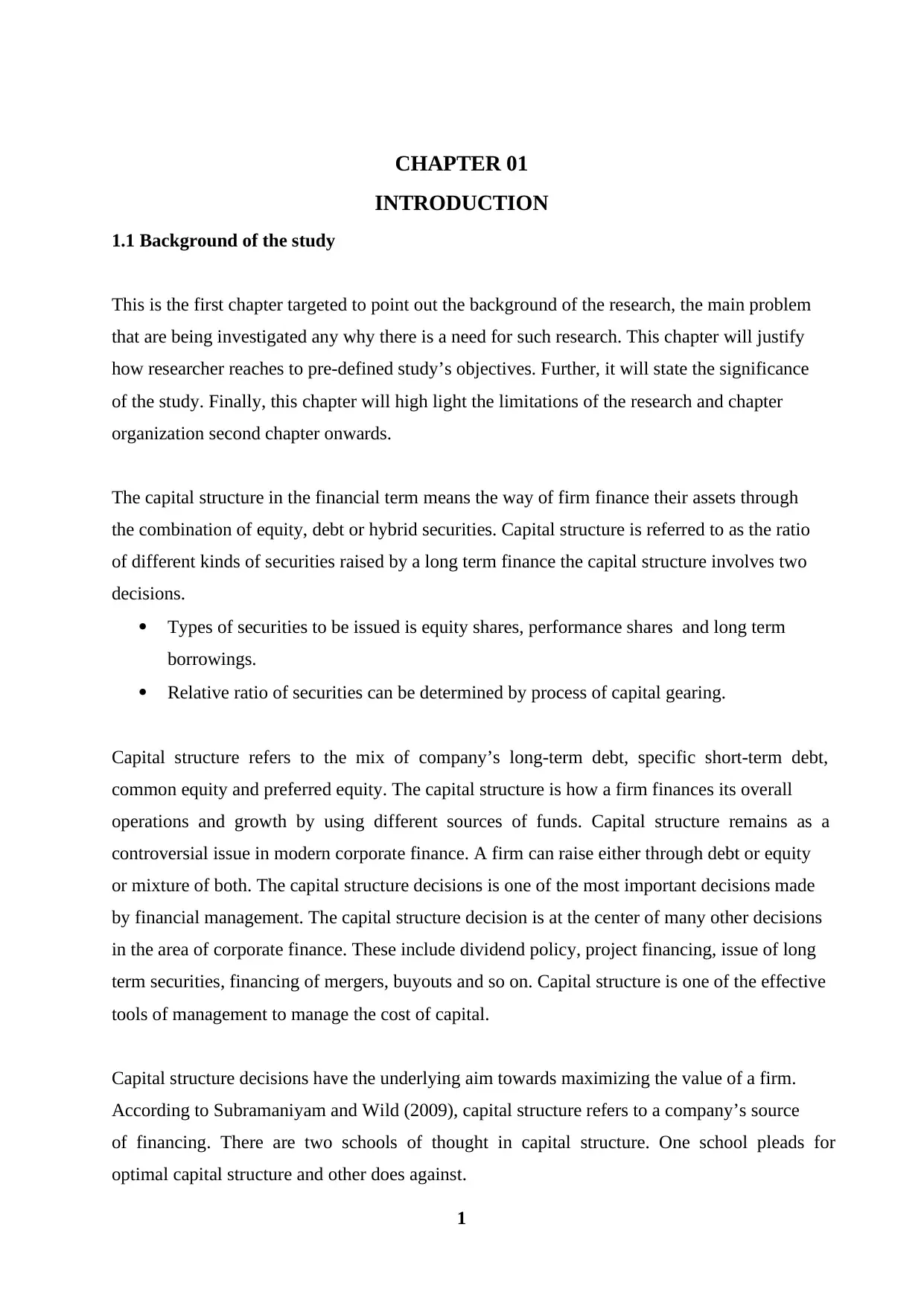
1
CHAPTER 01
INTRODUCTION
1.1 Background of the study
This is the first chapter targeted to point out the background of the research, the main problem
that are being investigated any why there is a need for such research. This chapter will justify
how researcher reaches to pre-defined study’s objectives. Further, it will state the significance
of the study. Finally, this chapter will high light the limitations of the research and chapter
organization second chapter onwards.
The capital structure in the financial term means the way of firm finance their assets through
the combination of equity, debt or hybrid securities. Capital structure is referred to as the ratio
of different kinds of securities raised by a long term finance the capital structure involves two
decisions.
Types of securities to be issued is equity shares, performance shares and long term
borrowings.
Relative ratio of securities can be determined by process of capital gearing.
Capital structure refers to the mix of company’s long-term debt, specific short-term debt,
common equity and preferred equity. The capital structure is how a firm finances its overall
operations and growth by using different sources of funds. Capital structure remains as a
controversial issue in modern corporate finance. A firm can raise either through debt or equity
or mixture of both. The capital structure decisions is one of the most important decisions made
by financial management. The capital structure decision is at the center of many other decisions
in the area of corporate finance. These include dividend policy, project financing, issue of long
term securities, financing of mergers, buyouts and so on. Capital structure is one of the effective
tools of management to manage the cost of capital.
Capital structure decisions have the underlying aim towards maximizing the value of a firm.
According to Subramaniyam and Wild (2009), capital structure refers to a company’s source
of financing. There are two schools of thought in capital structure. One school pleads for
optimal capital structure and other does against.
CHAPTER 01
INTRODUCTION
1.1 Background of the study
This is the first chapter targeted to point out the background of the research, the main problem
that are being investigated any why there is a need for such research. This chapter will justify
how researcher reaches to pre-defined study’s objectives. Further, it will state the significance
of the study. Finally, this chapter will high light the limitations of the research and chapter
organization second chapter onwards.
The capital structure in the financial term means the way of firm finance their assets through
the combination of equity, debt or hybrid securities. Capital structure is referred to as the ratio
of different kinds of securities raised by a long term finance the capital structure involves two
decisions.
Types of securities to be issued is equity shares, performance shares and long term
borrowings.
Relative ratio of securities can be determined by process of capital gearing.
Capital structure refers to the mix of company’s long-term debt, specific short-term debt,
common equity and preferred equity. The capital structure is how a firm finances its overall
operations and growth by using different sources of funds. Capital structure remains as a
controversial issue in modern corporate finance. A firm can raise either through debt or equity
or mixture of both. The capital structure decisions is one of the most important decisions made
by financial management. The capital structure decision is at the center of many other decisions
in the area of corporate finance. These include dividend policy, project financing, issue of long
term securities, financing of mergers, buyouts and so on. Capital structure is one of the effective
tools of management to manage the cost of capital.
Capital structure decisions have the underlying aim towards maximizing the value of a firm.
According to Subramaniyam and Wild (2009), capital structure refers to a company’s source
of financing. There are two schools of thought in capital structure. One school pleads for
optimal capital structure and other does against.
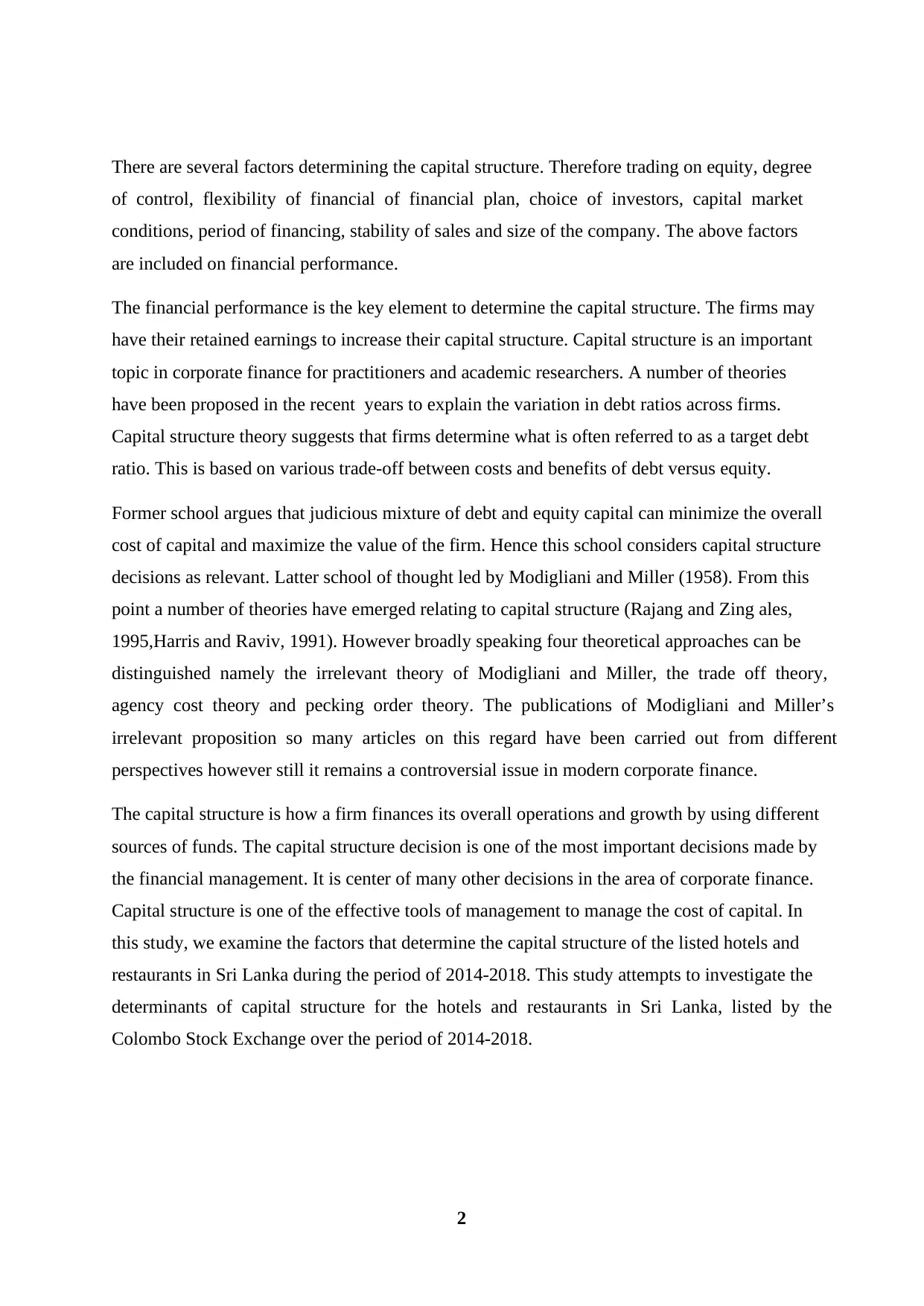
2
There are several factors determining the capital structure. Therefore trading on equity, degree
of control, flexibility of financial of financial plan, choice of investors, capital market
conditions, period of financing, stability of sales and size of the company. The above factors
are included on financial performance.
The financial performance is the key element to determine the capital structure. The firms may
have their retained earnings to increase their capital structure. Capital structure is an important
topic in corporate finance for practitioners and academic researchers. A number of theories
have been proposed in the recent years to explain the variation in debt ratios across firms.
Capital structure theory suggests that firms determine what is often referred to as a target debt
ratio. This is based on various trade-off between costs and benefits of debt versus equity.
Former school argues that judicious mixture of debt and equity capital can minimize the overall
cost of capital and maximize the value of the firm. Hence this school considers capital structure
decisions as relevant. Latter school of thought led by Modigliani and Miller (1958). From this
point a number of theories have emerged relating to capital structure (Rajang and Zing ales,
1995,Harris and Raviv, 1991). However broadly speaking four theoretical approaches can be
distinguished namely the irrelevant theory of Modigliani and Miller, the trade off theory,
agency cost theory and pecking order theory. The publications of Modigliani and Miller’s
irrelevant proposition so many articles on this regard have been carried out from different
perspectives however still it remains a controversial issue in modern corporate finance.
The capital structure is how a firm finances its overall operations and growth by using different
sources of funds. The capital structure decision is one of the most important decisions made by
the financial management. It is center of many other decisions in the area of corporate finance.
Capital structure is one of the effective tools of management to manage the cost of capital. In
this study, we examine the factors that determine the capital structure of the listed hotels and
restaurants in Sri Lanka during the period of 2014-2018. This study attempts to investigate the
determinants of capital structure for the hotels and restaurants in Sri Lanka, listed by the
Colombo Stock Exchange over the period of 2014-2018.
There are several factors determining the capital structure. Therefore trading on equity, degree
of control, flexibility of financial of financial plan, choice of investors, capital market
conditions, period of financing, stability of sales and size of the company. The above factors
are included on financial performance.
The financial performance is the key element to determine the capital structure. The firms may
have their retained earnings to increase their capital structure. Capital structure is an important
topic in corporate finance for practitioners and academic researchers. A number of theories
have been proposed in the recent years to explain the variation in debt ratios across firms.
Capital structure theory suggests that firms determine what is often referred to as a target debt
ratio. This is based on various trade-off between costs and benefits of debt versus equity.
Former school argues that judicious mixture of debt and equity capital can minimize the overall
cost of capital and maximize the value of the firm. Hence this school considers capital structure
decisions as relevant. Latter school of thought led by Modigliani and Miller (1958). From this
point a number of theories have emerged relating to capital structure (Rajang and Zing ales,
1995,Harris and Raviv, 1991). However broadly speaking four theoretical approaches can be
distinguished namely the irrelevant theory of Modigliani and Miller, the trade off theory,
agency cost theory and pecking order theory. The publications of Modigliani and Miller’s
irrelevant proposition so many articles on this regard have been carried out from different
perspectives however still it remains a controversial issue in modern corporate finance.
The capital structure is how a firm finances its overall operations and growth by using different
sources of funds. The capital structure decision is one of the most important decisions made by
the financial management. It is center of many other decisions in the area of corporate finance.
Capital structure is one of the effective tools of management to manage the cost of capital. In
this study, we examine the factors that determine the capital structure of the listed hotels and
restaurants in Sri Lanka during the period of 2014-2018. This study attempts to investigate the
determinants of capital structure for the hotels and restaurants in Sri Lanka, listed by the
Colombo Stock Exchange over the period of 2014-2018.
⊘ This is a preview!⊘
Do you want full access?
Subscribe today to unlock all pages.

Trusted by 1+ million students worldwide
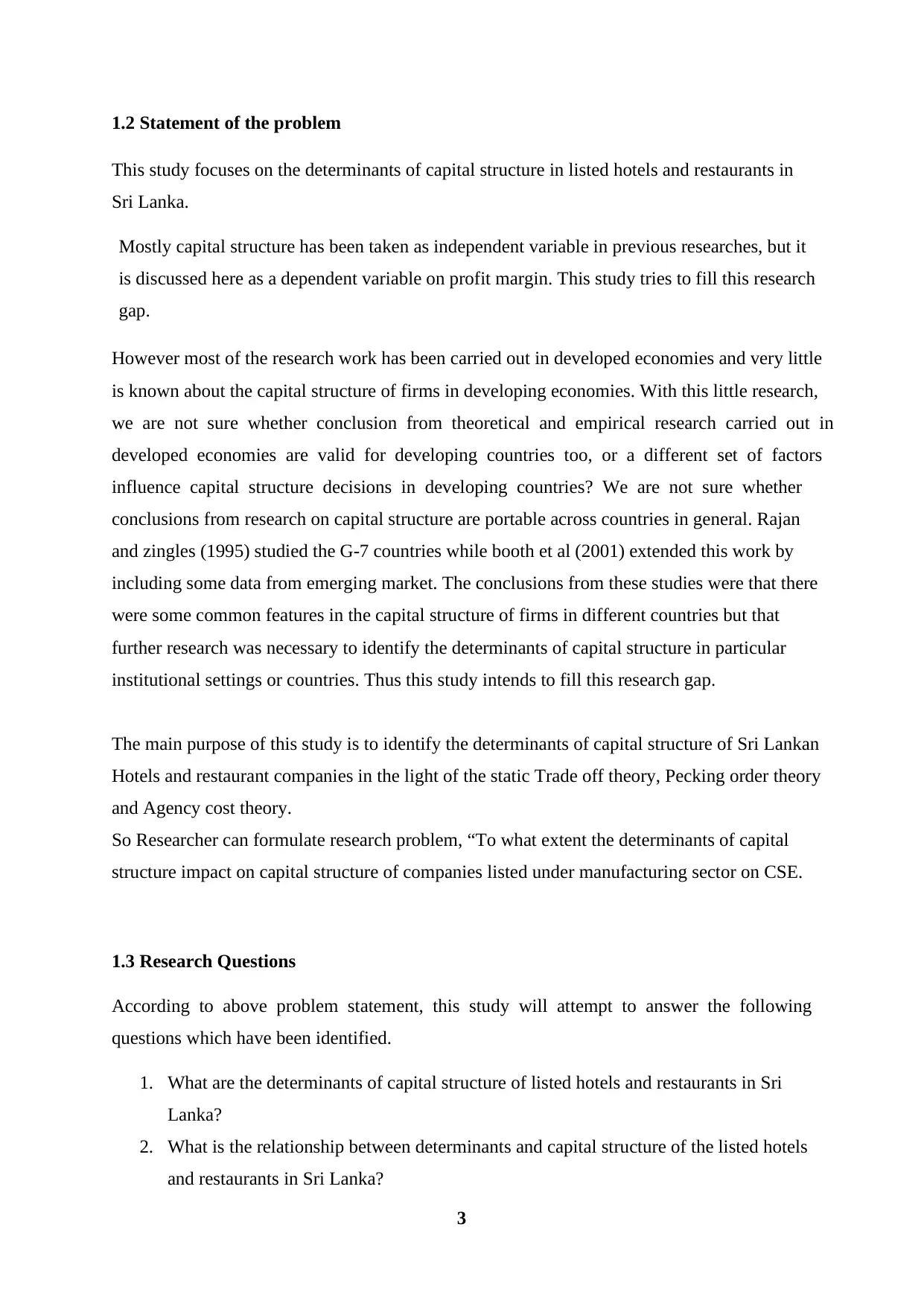
3
1.2 Statement of the problem
This study focuses on the determinants of capital structure in listed hotels and restaurants in
Sri Lanka.
Mostly capital structure has been taken as independent variable in previous researches, but it
is discussed here as a dependent variable on profit margin. This study tries to fill this research
gap.
However most of the research work has been carried out in developed economies and very little
is known about the capital structure of firms in developing economies. With this little research,
we are not sure whether conclusion from theoretical and empirical research carried out in
developed economies are valid for developing countries too, or a different set of factors
influence capital structure decisions in developing countries? We are not sure whether
conclusions from research on capital structure are portable across countries in general. Rajan
and zingles (1995) studied the G-7 countries while booth et al (2001) extended this work by
including some data from emerging market. The conclusions from these studies were that there
were some common features in the capital structure of firms in different countries but that
further research was necessary to identify the determinants of capital structure in particular
institutional settings or countries. Thus this study intends to fill this research gap.
The main purpose of this study is to identify the determinants of capital structure of Sri Lankan
Hotels and restaurant companies in the light of the static Trade off theory, Pecking order theory
and Agency cost theory.
So Researcher can formulate research problem, “To what extent the determinants of capital
structure impact on capital structure of companies listed under manufacturing sector on CSE.
1.3 Research Questions
According to above problem statement, this study will attempt to answer the following
questions which have been identified.
1. What are the determinants of capital structure of listed hotels and restaurants in Sri
Lanka?
2. What is the relationship between determinants and capital structure of the listed hotels
and restaurants in Sri Lanka?
1.2 Statement of the problem
This study focuses on the determinants of capital structure in listed hotels and restaurants in
Sri Lanka.
Mostly capital structure has been taken as independent variable in previous researches, but it
is discussed here as a dependent variable on profit margin. This study tries to fill this research
gap.
However most of the research work has been carried out in developed economies and very little
is known about the capital structure of firms in developing economies. With this little research,
we are not sure whether conclusion from theoretical and empirical research carried out in
developed economies are valid for developing countries too, or a different set of factors
influence capital structure decisions in developing countries? We are not sure whether
conclusions from research on capital structure are portable across countries in general. Rajan
and zingles (1995) studied the G-7 countries while booth et al (2001) extended this work by
including some data from emerging market. The conclusions from these studies were that there
were some common features in the capital structure of firms in different countries but that
further research was necessary to identify the determinants of capital structure in particular
institutional settings or countries. Thus this study intends to fill this research gap.
The main purpose of this study is to identify the determinants of capital structure of Sri Lankan
Hotels and restaurant companies in the light of the static Trade off theory, Pecking order theory
and Agency cost theory.
So Researcher can formulate research problem, “To what extent the determinants of capital
structure impact on capital structure of companies listed under manufacturing sector on CSE.
1.3 Research Questions
According to above problem statement, this study will attempt to answer the following
questions which have been identified.
1. What are the determinants of capital structure of listed hotels and restaurants in Sri
Lanka?
2. What is the relationship between determinants and capital structure of the listed hotels
and restaurants in Sri Lanka?
Paraphrase This Document
Need a fresh take? Get an instant paraphrase of this document with our AI Paraphraser

4
1.4 Research Objectives
This research study is aim to achieve the following objectives.
1. To identify the determinants of capital structure of the listed hotels and restaurants in
Sri Lanka.
2. To examine the relationship between determinants and capital structure of listed hotels
and restaurants in Sri Lanka.
1.5 Significance of the Study
This research examine the “Determinants of capital structure: A study of listed hotels and
restaurants of Colombo Stock Exchange (CSE), Sri Lanka” analysis at the overall level. The
primary objective of this study is to identify the relationship between capital structure and
determinants of listed hotels and restaurants in CSE.
The secondary objective is to identify the factors that influence on capital structure of listed
hotels and restaurants of Colombo Stock Exchange (CSE), Sri Lanka.
To understand how companies finance their operations, it is necessary to examine the
determinants of their financing or capital structure decisions. Company financing decisions
involve a wide range of policy issues. At the private, they have implications for capital market
development, interest rate and security price determination and regulation.
The result of this study are deemed to benefit the following users.
External investors and shareholders who will be able to know the main variable’s that
affect the capital structure and to observe firm’s performance before making the
decisions of whether or not to sell the stock.
Professional managers who can consider these determinants of capital structure to
establish the optimal financing vehicle that helps achieve the companies and firm
objectives.
Lenders who may find the result in evaluating the firm’s performance before giving
loans with particular emphasis on the level of risk involved.
As a developing country Sri Lanka has become an emerging market with lot of potential
of investment that gets an attention for investors and mergers to think about the
influencing factors of using debt and their extend of influence over the firms.
This study will help the managers to take the financing decision for their firms. The
creditors can also take the benefits to minimize their risk in funding in listed companies.
1.4 Research Objectives
This research study is aim to achieve the following objectives.
1. To identify the determinants of capital structure of the listed hotels and restaurants in
Sri Lanka.
2. To examine the relationship between determinants and capital structure of listed hotels
and restaurants in Sri Lanka.
1.5 Significance of the Study
This research examine the “Determinants of capital structure: A study of listed hotels and
restaurants of Colombo Stock Exchange (CSE), Sri Lanka” analysis at the overall level. The
primary objective of this study is to identify the relationship between capital structure and
determinants of listed hotels and restaurants in CSE.
The secondary objective is to identify the factors that influence on capital structure of listed
hotels and restaurants of Colombo Stock Exchange (CSE), Sri Lanka.
To understand how companies finance their operations, it is necessary to examine the
determinants of their financing or capital structure decisions. Company financing decisions
involve a wide range of policy issues. At the private, they have implications for capital market
development, interest rate and security price determination and regulation.
The result of this study are deemed to benefit the following users.
External investors and shareholders who will be able to know the main variable’s that
affect the capital structure and to observe firm’s performance before making the
decisions of whether or not to sell the stock.
Professional managers who can consider these determinants of capital structure to
establish the optimal financing vehicle that helps achieve the companies and firm
objectives.
Lenders who may find the result in evaluating the firm’s performance before giving
loans with particular emphasis on the level of risk involved.
As a developing country Sri Lanka has become an emerging market with lot of potential
of investment that gets an attention for investors and mergers to think about the
influencing factors of using debt and their extend of influence over the firms.
This study will help the managers to take the financing decision for their firms. The
creditors can also take the benefits to minimize their risk in funding in listed companies.
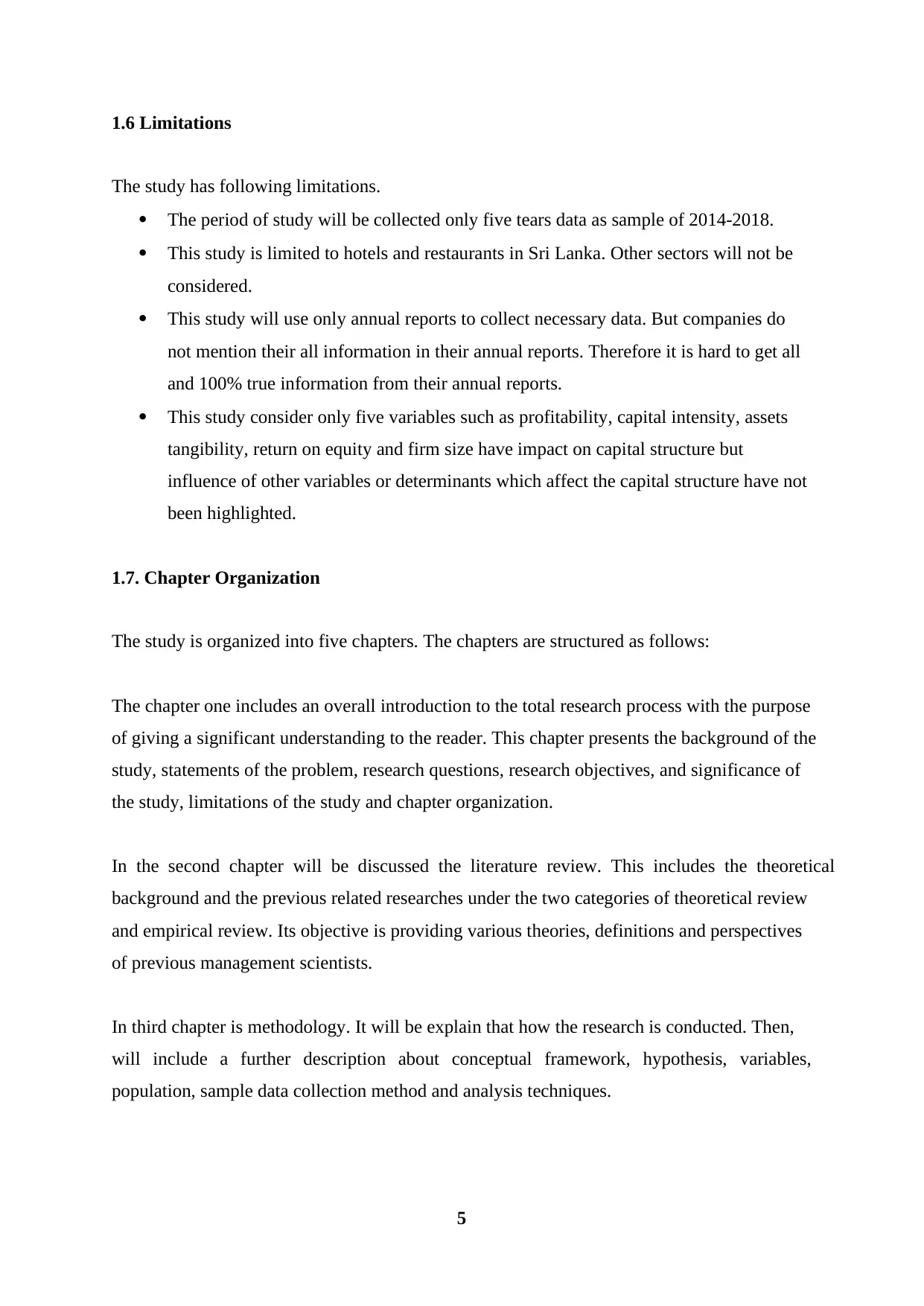
5
1.6 Limitations
The study has following limitations.
The period of study will be collected only five tears data as sample of 2014-2018.
This study is limited to hotels and restaurants in Sri Lanka. Other sectors will not be
considered.
This study will use only annual reports to collect necessary data. But companies do
not mention their all information in their annual reports. Therefore it is hard to get all
and 100% true information from their annual reports.
This study consider only five variables such as profitability, capital intensity, assets
tangibility, return on equity and firm size have impact on capital structure but
influence of other variables or determinants which affect the capital structure have not
been highlighted.
1.7. Chapter Organization
The study is organized into five chapters. The chapters are structured as follows:
The chapter one includes an overall introduction to the total research process with the purpose
of giving a significant understanding to the reader. This chapter presents the background of the
study, statements of the problem, research questions, research objectives, and significance of
the study, limitations of the study and chapter organization.
In the second chapter will be discussed the literature review. This includes the theoretical
background and the previous related researches under the two categories of theoretical review
and empirical review. Its objective is providing various theories, definitions and perspectives
of previous management scientists.
In third chapter is methodology. It will be explain that how the research is conducted. Then,
will include a further description about conceptual framework, hypothesis, variables,
population, sample data collection method and analysis techniques.
1.6 Limitations
The study has following limitations.
The period of study will be collected only five tears data as sample of 2014-2018.
This study is limited to hotels and restaurants in Sri Lanka. Other sectors will not be
considered.
This study will use only annual reports to collect necessary data. But companies do
not mention their all information in their annual reports. Therefore it is hard to get all
and 100% true information from their annual reports.
This study consider only five variables such as profitability, capital intensity, assets
tangibility, return on equity and firm size have impact on capital structure but
influence of other variables or determinants which affect the capital structure have not
been highlighted.
1.7. Chapter Organization
The study is organized into five chapters. The chapters are structured as follows:
The chapter one includes an overall introduction to the total research process with the purpose
of giving a significant understanding to the reader. This chapter presents the background of the
study, statements of the problem, research questions, research objectives, and significance of
the study, limitations of the study and chapter organization.
In the second chapter will be discussed the literature review. This includes the theoretical
background and the previous related researches under the two categories of theoretical review
and empirical review. Its objective is providing various theories, definitions and perspectives
of previous management scientists.
In third chapter is methodology. It will be explain that how the research is conducted. Then,
will include a further description about conceptual framework, hypothesis, variables,
population, sample data collection method and analysis techniques.
⊘ This is a preview!⊘
Do you want full access?
Subscribe today to unlock all pages.

Trusted by 1+ million students worldwide
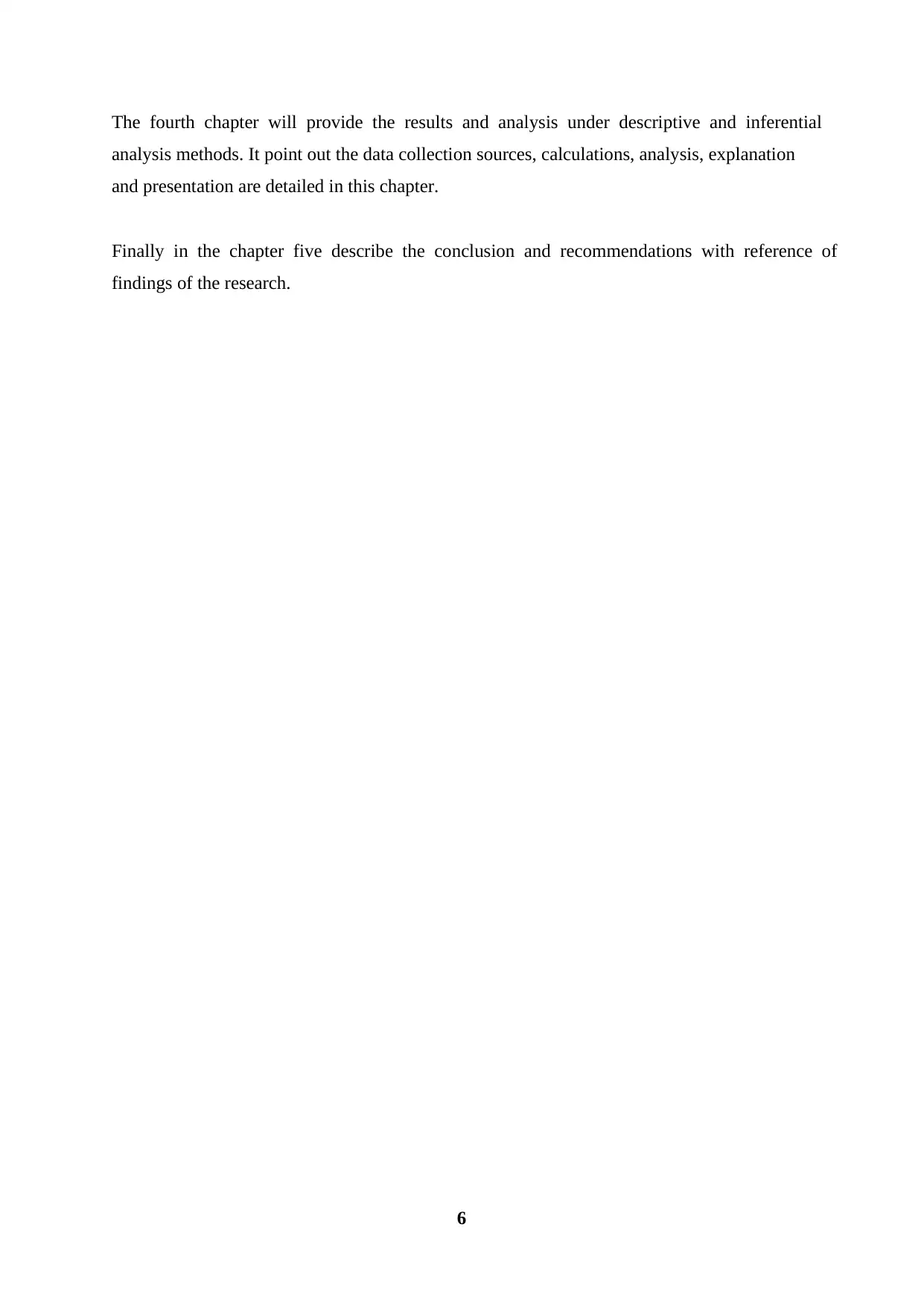
6
The fourth chapter will provide the results and analysis under descriptive and inferential
analysis methods. It point out the data collection sources, calculations, analysis, explanation
and presentation are detailed in this chapter.
Finally in the chapter five describe the conclusion and recommendations with reference of
findings of the research.
The fourth chapter will provide the results and analysis under descriptive and inferential
analysis methods. It point out the data collection sources, calculations, analysis, explanation
and presentation are detailed in this chapter.
Finally in the chapter five describe the conclusion and recommendations with reference of
findings of the research.
1 out of 7
Related Documents
Your All-in-One AI-Powered Toolkit for Academic Success.
+13062052269
info@desklib.com
Available 24*7 on WhatsApp / Email
![[object Object]](/_next/static/media/star-bottom.7253800d.svg)
Unlock your academic potential
Copyright © 2020–2025 A2Z Services. All Rights Reserved. Developed and managed by ZUCOL.




